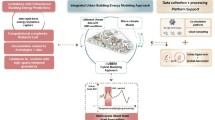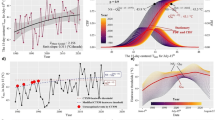Abstract
Anthropogenic heating by human activity is one of the key contributing factors in forming urban heat islands, thus inclusion of the heat source plays an important role in urban meteorological and environmental modeling. In this study, gridded anthropogenic heat flux (AHF) with high spatial (1-km) and temporal (1-hr) resolution is estimated for the whole South Korea region in year 2010 using a statistical regression method which derives based on similarity of anthropogenic air pollutant emissions and AHF in their emission inventories. The bottom-up anthropogenic pollutant emissions required for the regression method are produced using the intensive Korean air pollutants emission inventories. The calculated regression-based AHF compares well with the inventory-based AHF estimation for the Gyeong-In region, demonstrating that the statistical regression method can reasonably represent spatio-temporal variation of the AHF within the region. The estimated AHF shows that for major Korean cities (Seoul, Busan, Daegu, Gwangju, Daejeon, and Ulsan) the annual mean AHF range 10–50 Wm−2 on a grid scale and 20–30W m−2 on a city-scale. The winter AHF are larger by about 22% than that in summer, while the weekday AHF are larger by 4–5% than the weekend AHF in the major Korean cities. The gridded AHF data estimated in this study can be used in mesoscale meteorological and environmental modeling for the South Korea region.
Similar content being viewed by others
References
Allen, L., F. Lindberg, and C. S. B. Grimmond, 2010: Global to city scale urban anthropogenic heat flux: model and variability. Int. J. Climatol., 31, doi:10.1002/joc.2210.
Block, A., K. Keuler, and E. Schaller, 2004: Impacts of anthropogenic heat on regional climate patterns. Geophy. Res. Lett., 31: L12211, 1–4.
Chen, Y., W. Jiang, N. Zhang, X. He, and R. Zhou, 2009: Numerical simulation of the anthropogenic heat effect on urban boundary layer structure. Theor. Appl. Climatol., 97, 123–134.
Coats, C. J., 1996: High performance algorithms in the sparse matrix operator kernel emissions (SMOKE) modeling system. Proceedings of the Ninth AMS Joint Conference on Applications of Air Pollution Meteorology with AWMA, American Meteorological Society, Atlanta, GA (1996), 584–588.
Crutzen, P. J., 2004: New directions: The growing urban heat and pollution “island” effect-Impact on chemistry and climate. Atmos. Environ., 38, 3539–3540.
Fan, H., and D. J. Sailor, 2005: Modeling the impacts of anthropogenic heating on the urban climate of Philadelphia: A comparison of implementations in two PBL schemes. Atmos. Environ., 39, 73–84.
Flanner, M. G., 2009: Integrating anthropogenic heat flux with global climate models. Geophy. Res. Lett., 36: L02801, doi: 10.1029/2008GLO36465.
Heiple, S., and D. J. Sailor, 2008: Using building energy simulation and geospatial modeling techniques to determine high resolution building sector energy consumption profiles. Energ. Buildings, 40, 1426–1436.
Iamarino, M., S. Beevers, and C. S. B. Grimmond, 2012: High-resolution (space, time) anthropogenic heat emissions: London 1970-2025. Int. J. Climatol., 32, 1754–1767.
Ichinose, T., K. Shimodozono, and K. Hanaki, 1999: Impact of anthropogenic heat on urban climate in Tokyo. Atmos. Environ., 33, 3897–3909.
Khan, S. M., and R. W. Simpson, 2001: Effect of a heat island on the meteorology of a complex urban airshed. Bound.-Layer Meteor., 100, 487–506.
Korea Energy Economics Institute (KEEI), 2011: 2011 yearbook of regional energy statistics, 319 pp.
—, 2012: Monthly energy statistics, Vol. 28, Issue 1, 66 pp.
Kikegawa, Y., Y. Genchi, H. Yoshikado, and H. Kondo, 2003: Development of a numerical simulation system toward comprehensive assessments of urban warming countermeasures including their impacts upon the urban buildings' energy-demands. Appl. Energ., 76, 449–466.
—, Y. Genchi, H. Kondo, and K. Hanaki, 2006: Impacts of cityblock-scale countermeasures against urban heat-island phenomena upon a building’s energy-consumption for air-conditioning. Appl. Energ., 83, 649–668.
Kim, S.-T., N.-K. Moon, and D. W. Byun, 2008: Korea emissions inventory processing using the US EPA’s SMOKE system. Asian J. Atmos. Environ., 2–1, 34–46.
Kłysik, K., 1996: Spatial and seasonal distribution of anthropogenic heat emissions in Lodz, Poland. Atmos. Environ., 30, 3397–3404.
Lee, S.-H., 2008: Development of a vegetated urban canopy model and its application to urban heat island simulations. Ph.D. Dissertation, Seoul National University, 184 pp.
—, S. A. McKeen, and D. Sailor, 2014: A regression approach for estimation of anthropogenic heat flux based on a bottom-up air pollutant emission database. Atmos. Environ., 95, 629–633.
—, C.-K. Song, J.-J. Baik, and S.-U. Park, 2009: Estimation of anthropogenic heat emission in the Gyeong-In region of Korea. Theor. Appl. Climatol., 96, 291–303.
Makar, P., S. Gravel, V. Chirkov, K. Strawbridge, F. Froude, J. Arnold, and J. Brook, 2006: Heat flux, urban properties, and regional weather. Atmos. Environ., 40, 2750–2766.
Morita, M., 1993: Study on heat exhaust structure of major cities in Japan (in Japanese with English abstract). Environ. Syst. Res., 21, 19–26.
Moriwaki, R., H. Senoh, M. Kanda, A. Hagishima, and T. Kinouchi, 2008: Anthropogenic water vapor emissions in Tokyo. Water Resour. Res., 44: W11424, doi:10.1029/2007WR006624.
Narumi, D., A. Kondo, and Y. Shimoda, 2009: Effects of anthropogenic heat release upon the urban climate in a Japanese megacity. Environ. Res., 109, 421–431, doi:10.1016/j.envres.2009.02.013.
Offerle, B., C. S. B. Grimmond, and K. Fortuniak, 2005: Heat storage and anthropogenic heat flux in relation to the energy balance of a central European city centre. Int. J. Climatol., 25, 1405–1419, doi: 10.1002/joc.1198.
Ohashi, Y., Y. Genchi, H. Kondo, Y. Kikegawa, H. Yoshikado, and Y. Hirano, 2007: Influence of air-conditioning waste heat on air temperature in Tokyo during summer: Numerical experiments using an urban canopy model coupled with a building energy model. J. Appl. Meteor. Climatol., 46, 66–81.
Park, M.-S., S.-J. Joo, and S.-U. Park, 2014: Carbon dioxide concentration and flux in an urban residential area in Seoul, Korea. Adv. Atmos. Sci., 31(5), 1101–1112, doi: 10.1007/s00376-013-3168-y.
Pigeon, G., D. Legain, P. Durand, and V. Masson, 2007: Anthropogenic heat release in an old European agglomeration (Toulouse, France). Int. J. Climatol., 27, 1969–1981.
Ryu, Y.-H., J.-J. Baik, and S.-H. Lee, 2013: Effects of anthropogenic heat on ozone air quality in a megacity. Atmos. Environ., 80, 20–30.
Sailor, D. J., 2011: A review of methods for estimating anthropogenic heat and moisture emissions in the urban environment. Int. J. Climatol., 31, 189–199.
—, and L. Lu, 2004: A top-down methodology for developing diurnal and seasonal anthropogenic heating profiles for urban areas. Atmos. Environ., 38, 2737–2748.
—, A. Brooks, M. Hart, and S. Heiple, 2007: A bottom-up approach for estimating latent and sensible heat emissions from anthropogenic sources. Proceedings of 7th symposium on the urban environment, San Diego, CA, American Meteorological Society.
Smith, C., S. Lindley, and G. Levermore, 2009: Estimating spatial and temporal patterns of urban anthropogenic heat fluxes for UK cities: The case of Manchester. Theor. Appl. Climatol., 98, 19–35.
Son, E.-H., Y.-K. Kim, and J.-H. Hong, 2000: Study on estimation of urban anthropogenic heat generation. J. Korean Soc. Atmos. Environ., 16, 37–47. (in Korean with English abstract)
Zhang, X., M. A. Friedl, C. B. Schaaf, A. H. Strahler, and A. Schneider, 2004: The footprint of urban climates on vegetation phenology. Geophy. Res. Lett., 31, doi: 10.1029/2004GL020137.
Author information
Authors and Affiliations
Corresponding author
Rights and permissions
About this article
Cite this article
Lee, SH., Kim, ST. Estimation of anthropogenic heat emission over South Korea using a statistical regression method. Asia-Pacific J Atmos Sci 51, 157–166 (2015). https://doi.org/10.1007/s13143-015-0065-6
Received:
Accepted:
Published:
Issue Date:
DOI: https://doi.org/10.1007/s13143-015-0065-6




